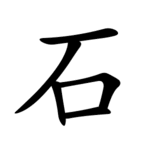| 石 | ||
|---|---|---|
| ||
| 石 (U+77F3) "stone" | ||
| Pronunciations | ||
| Pinyin: | shí | |
| Bopomofo: | ㄕˊ | |
| Gwoyeu Romatzyh: | shyr | |
| Wade–Giles: | shih2 | |
| Cantonese Yale: | sehk | |
| Jyutping: | sek6 | |
| Japanese Kana: | セキ seki / シャク shaku / コク koku (on'yomi) いし ishi (kun'yomi) | |
| Sino-Korean: | 석 seok | |
| Names | ||
| Chinese name(s): | (Left) 石字旁 shízìpáng (Bottom) 石字底 shízìdǐ | |
| Japanese name(s): | 石/いし ishi (Left) 石偏/いしへん ishihen | |
| Hangul: | 돌 dol | |
| Stroke order animation | ||
 | ||
Radical 112 or radical stone (石部) meaning "stone" (石头) is one of the 23 Kangxi radicals (214 radicals in total) composed of 5 strokes.
In the Kangxi Dictionary, there are 499 characters (out of 49,030) to be found under this radical.
石 is also the 102nd indexing component in the Table of Indexing Chinese Character Components predominantly adopted by Simplified Chinese dictionaries published in mainland China.
Evolution
 Oracle bone script character
Oracle bone script character Bronze script character
Bronze script character Large seal script character
Large seal script character Small seal script character
Small seal script character
Derived characters
| Strokes | Characters |
|---|---|
| +0 | 石 |
| +2 | 矴 (=碇) 矵 矶SC (=磯) |
| +3 | 矷 矸 矹 矺 矻 矼 矽 矾SC (=礬) 矿SC (=礦) 砀SC (=碭) 码SC (=碼) |
| +4 | 泵 砂 砃 砄 砅 砆 砇 (=珉 -> 玉) 砈 砉 砊 砋 砌 砍 砎 砏 砐 砑 砒 砓 研 砕JP (=碎) 砖SC (=磚) 砗SC (=硨) 砘 砙 砚SC (=硯) 砛 砜SC (=碸) |
| +5 | 砝 砞 砟 砠 砡 砢 砣 砤 砥 砦 砧 砨 砩 砪 砫 砬 砭 砮 砯 砰 砱 砲TC variant/JP -> 火 (=炮) 砳 破 砵 砶 砷 砸 砹 砺SC (=礪) 砻SC (=礱) 砼 砽 砾SC (=礫) 砿JP nonstandard (=礦) 础SC (=礎) 硁SC (=硜) |
| +6 | 硂 硃 硄 硅 硆 硇 硈 硉 硊 硋 硌 硍 硎 硏 (=研 硯) 硐 硑 (=砰 / 瓶 -> 瓦 研) 硒 硓 硔 硕SC (=碩) 硖SC (=硤) 硗SC (=磽) 硘 硙SC (=磑) 硚SC (=礄) 硛 |
| +7 | 硜 硝 硞 硟 硠 硡 硢 硣 硤 硥 硦 硧 硨 硩 硪 硫 硬 硭 确 (also SC form of 確) 硯 硰 硱 硲 硳 硴 硵SC (=磠) 硶 硷SC (obsolete) (=鹼) |
| +8 | 硸 硹 硺 硻 硼 硽 硿 碀 碁 (=棋 -> 木) 碂 碃 碄 碅 碆 碇 碈 碉 碊 碋 碌 碍SC (=礙) 碎 碏 碐 碑 碒 碓 碔 碕 碖 碗 碘 碙 碚 碛SC (=磧) 碜SC (=磣) 碰 |
| +9 | 硾 碝 碞 碟 碠 碡 碢 碣 碤 碥 碦 碧 碨 碩 碪 碫 碬 碭 碮 碯 (=瑙 -> 玉) 碱SC (=鹼) 碲 碳 碴 碵 碶 碷 碸 碹 磁 |
| +10 | 確 碻 碼 碽 碾 碿 磀 磂 (=硫 / 鎦 -> 金) 磃 磄 磅 磆 磇 磈 磉 磊 磋 磌 磍 磎 (=谿 -> 谷) 磏 磐 磑 磒 (=隕 -> 阜) 磓 磔 磕 磖 磗 磘 磙 磜 磤 |
| +11 | 磚 磛 磝 磞 磟 磠 磡 磢 磣 磥 磦 磧 磨 磩 磪 磫 磬 磭 磮 |
| +12 | 磯 磰 磱 磲 磳 磴 磵 磶 磷 磸 磹 磺 磻 磼 磽 磾 磿 礀 礁 礂 礃 礄 礅 |
| +13 | 礆 (=險 -> 阜 / 鹼 -> 鹵) 礇 礈 礉 礊 礋 礌 礍 礎 礏 礐 礑 礒 礓 礔 礕 礖 |
| +14 | 礗 礘 礙 礚 (=磕) 礛 礜 礝 礞 礟 礠 (=磁) 礡 |
| +15 | 礢 礣 礤 礥 礦 礧 礨 礩 礪 礫 礬 |
| +16 | 礭 礮 (=炮 -> 火) 礯 礰 礱 礲 礳 礴 |
| +17 | 礵 |
| +18 | 礶 礷 |
| +19 | 礸 |
| +20 | 礹 |
Sinogram
As an independent sinogram it is one of the Kyōiku kanji or Kanji taught in elementary school in Japan.[1] It is a first grade kanji.[1]
References
- 1 2 "The Kyoiku Kanji (教育漢字) - Kanshudo". www.kanshudo.com. Archived from the original on March 24, 2022. Retrieved 2023-05-06.
Literature
- Fazzioli, Edoardo (1987). Chinese calligraphy : from pictograph to ideogram : the history of 214 essential Chinese/Japanese characters. calligraphy by Rebecca Hon Ko. New York: Abbeville Press. ISBN 0-89659-774-1.
- Lunde, Ken (Jan 5, 2009). "Appendix J: Japanese Character Sets" (PDF). CJKV Information Processing: Chinese, Japanese, Korean & Vietnamese Computing (Second ed.). Sebastopol, Calif.: O'Reilly Media. ISBN 978-0-596-51447-1.
External links
Wikimedia Commons has media related to Radical 112.
This article is issued from Wikipedia. The text is licensed under Creative Commons - Attribution - Sharealike. Additional terms may apply for the media files.